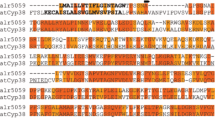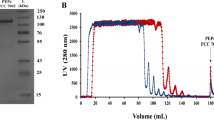Abstract
Prolyl hydroxylase, which is responsible for the hydroxylation of peptidyl proline residues, has been isolated and purified from the green alga Chlamydomonas reinhardii. The enzyme, which appears to be loosely associated with microsomal membranes, was released into solution by sonication in the presence of detergent. Purification was achieved by ion-exchange chromatography followed by affinity chromatography using the immobilized substrate poly-L-proline. Apart from its differing substrate specificity the enzyme appears to possess similar molecular characteristics to prolyl hydroxylase isolated from animal tissues: the active enzyme is a tetramer of about 240–250 kDa and nonidentical monomers of 65 and 60 kDa. The monomers are capsule shaped having a dimension of 12×7 nm.
Similar content being viewed by others
Abbreviations
- Da:
-
dalton
- DEAE:
-
diethylaminoethyl
- DTT:
-
dithiothreitol
- Hepes:
-
4-(2-hydroxymethyl)-1-piperazine ethanesulfonic acid
- α-KGA:
-
α-ketoglutarate
- PAGE:
-
polyacrylamide gel electrophoresis
- SDS:
-
sodium dodecyl sulfate
References
Berg, R.A., Kedersha, N.L., Guzman, N.A. (1979) Purification and partial characterization of the two nonidentical subunits of prolyl hydroxylase. J. Biol. Chem. 254, 3111–3118
Berg, R.A., Prockop, D.J. (1973) Affinity column purification of protocollagen proline hydroxylase from chick embryos and further characterization of the enzyme. J. Biol. Chem. 218, 1175–1182
Bolwell, G.P., Robbins, M.P., Dixon, R.A. (1985) Elicitor-induced prolyl hydroxylase from French bean (Phaseolus vulgaris). Biochem. J. 229 693–699
Bradford, M.M. (1976) A rapid and sensitive method for the quantitation of microgram quantities of protein utilizing the principle of protein-dye binding. Anal. Biochem. 72, 248–254
Cardinale, G.J., Udenfriend, S. (1974) Prolyl hydroxylase. In: Adv. Enzymol. Relat. Areas Mol. Biol. 41, 245–301
Catt, J.W., Hills, G.J., Roberts, K. (1976) A structural glycoprotein, containing hydroxyproline isolated from the cell wall of Chlamydomonas reinhardii. Planta 131, 165–171
Drozdz, M., Kurcharz, E., Szyja, J. (1976) A colorimetric micromethod for determination of hydroxyproline in blood serum. Z. Med. Labortech. 17, 163–171
Erickson, S.S., Fukudal, M., Varner, J.E. (1984) Specificity of prolyl hydroxylase from carrot root discsl. Plant Physiol. 75, Suppl. 28
Fincher, G.B., Stone, B.A., Clarke, A.E. (1983) Arabinogalactan-proteins: structure, biosynthesis and function. Annu. Rev. Plant Physiol. 34, 47–70
Harwood, R., Grant, M.E., Jackson, D.S. (1974) Collagen biosynthesis. Characterization of subcellular fractions from embryonic chick fibroblasts and the intracellular localization of protocollagen prolyl and protocollagen lysyl hydroxylases. Biochem. J. 144, 123–130
Kedersha, N.L., Tkaez, J.S., Berg, R.A. (1985) Characterization of the oligosaccharides of prolyl hydroxylase, a microsomal glycoprotein. Biochemistry 24, 5952–5960
Kivirikko, K.I., Myllylä, R. (1980) The hydroxylation of prolyl and lysyl residue. In: The enzymology of posttranslational modifications of proteins, pp. 52–104, Freedman, R.B., Hawkins, H.C., eds. Academic Press, New York London
Kivirikko, K.I., Myllyla, R. (1982) Posttranslational enzymes in the biosynthesis of collagen: intracellular enzymes. Methods Enzymo. 82, 245–284
Kivirikko, K.I., Prockop, D.J. (1967) Purification and partial characterization for the enzyme for the hydroxylation of proline in protocollagen. Arch. Biochem. Biophys. 118, 611–618
Kuutti, E.-R., Tuderman, L., Kivirikko, K.I. (1975) Human prolyl hydroxylase. Purification, partial characterization and preparations of antiserum to the enzyme. Eur. J. Biochem. 57, 181–188
Olsen, B.R., Berg, R.A., Kivirikko, K.I., Prockop, D.J. (1973) Structure of protocollagen proline hydroxylase from chick embryos. Eur. J. Biochem. 35, 135–147
Peterson, G.L. (1977) A simplification of the protein assay method of Lowry et al. which is more generally applicable. Anal. Biochem. 83, 346–356
Prockop, D.J., Kivirikko, K.I. (1969) Effect of polymer size on the inhibition of protocollagen proline hydroxylase by polyproline II. J. Biol. Chem. 214, 4838–4842
Robinson, D.G. (1985) Plant membranes: Endo- and plasma membranes of plant cells. Cell biology monographs, vol. 3, Bittar, E.E., ed. John Wiley, New York
Robinson, D.G., Andreae, M., Sauer, A. (1985) Hydroxyproline-rich glycoprotein biosynthesis: a comparison with that of collagen. In: Biochemistry of plant cell walls, pp. 155–176, Brett, C.T., Hillman, J.R., eds. Cambridge University Press, Cambridge
Ryhänen, L., Kivirikko, K.I. (1974) Hydroxylation of lysyl residues in native and denatured protocollagen by protocollagen lysyl hydroxylase in vitro. Biochim. Biophys. Acta 343, 129–137
Sadava, D., Chrispeels, M.J. (1971) Hydroxyproline biosynthesis in plant cells. Peptidyl proline hydroxylase from carrot root disks. Biochim. Biophys. Acta 227, 278–287
Sauer, A., Robinson, D.G. (1985) Intracellular localization of posttranslational modifications in the synthesis of hydroxyproline-rich glycoproteins. I. Peptidyl proline hydroxylation in maize roots. Planta 164, 287–294
Smith, J.J., Muldon, E.P., Willard, J.J., Lamport, D.T.A. (1986) Tomato extensin precursors P1 and P2 are highly periodic structures. Phytochemistry 25, 102–1030
Surzycki, S. (1971) Synchronously grown cultures of Chlamydomonas reinhardii. Meth. Enzymol. 23A, 67–73
Tanaka, M., Sato, K., Uchida, T. (1981) Plant prolyl hydroxylase recognizes poly (1-proline) II helix. J. Biol. Chem. 256, 22397–22400
Tanaka, M., Shibata, H., Uchida, T. (1980) A new prolyl hydroxylase acting on poly-1-proline from suspension cultured cells of Vinca rosea. Biochim. Biophys. Acta 616, 188–198
Tuderman, L., Kuutti, E.-R., Kivirikko, K.I. (1975) An affinity-column procedure using poly (1-proline) for the purification of prolyl hydroxylase. Purification of the enzyme from chick embryos. Eur. J. Biochem. 52, 9–16
Author information
Authors and Affiliations
Rights and permissions
About this article
Cite this article
Blankenstein, P., Lang, W.C. & Robinson, D.G. Isolation and characterization of prolyl hydroxylase from Chlamydomonas reinhardii . Planta 169, 238–244 (1986). https://doi.org/10.1007/BF00392320
Received:
Accepted:
Issue Date:
DOI: https://doi.org/10.1007/BF00392320




